OpenEye2016
OpenEye16 is a series of guest lectures by theorists, artists and lecturers addressing the themes of contemporary arts and new technologies. The lectures are open to students of FAMU and other art academies, universities and the general public. They are held in English or simultaneously translated.
FAMU, Smetanovo náb. 2, Praha 1
Room U1, 1st floor.
www.famu.cz

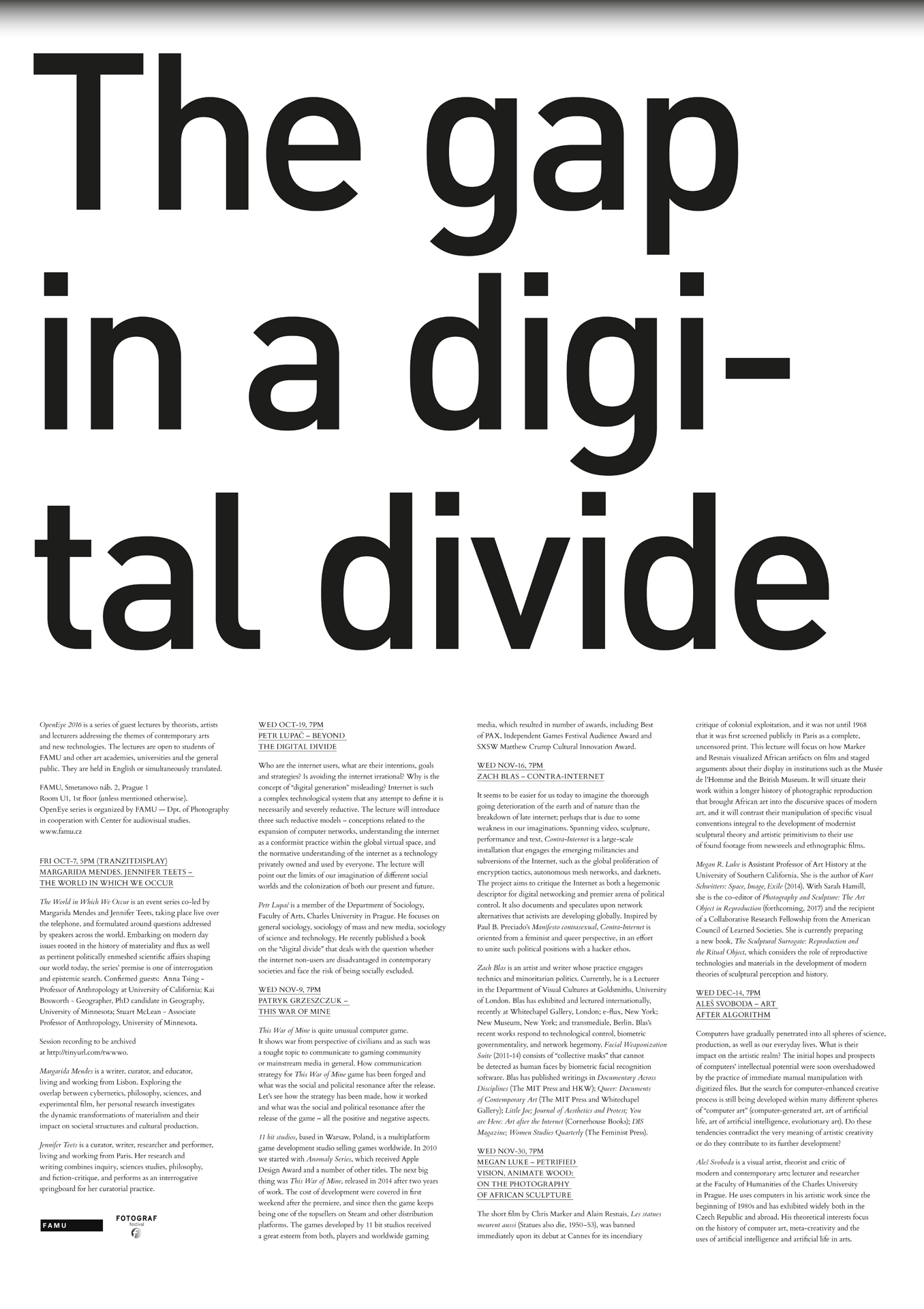

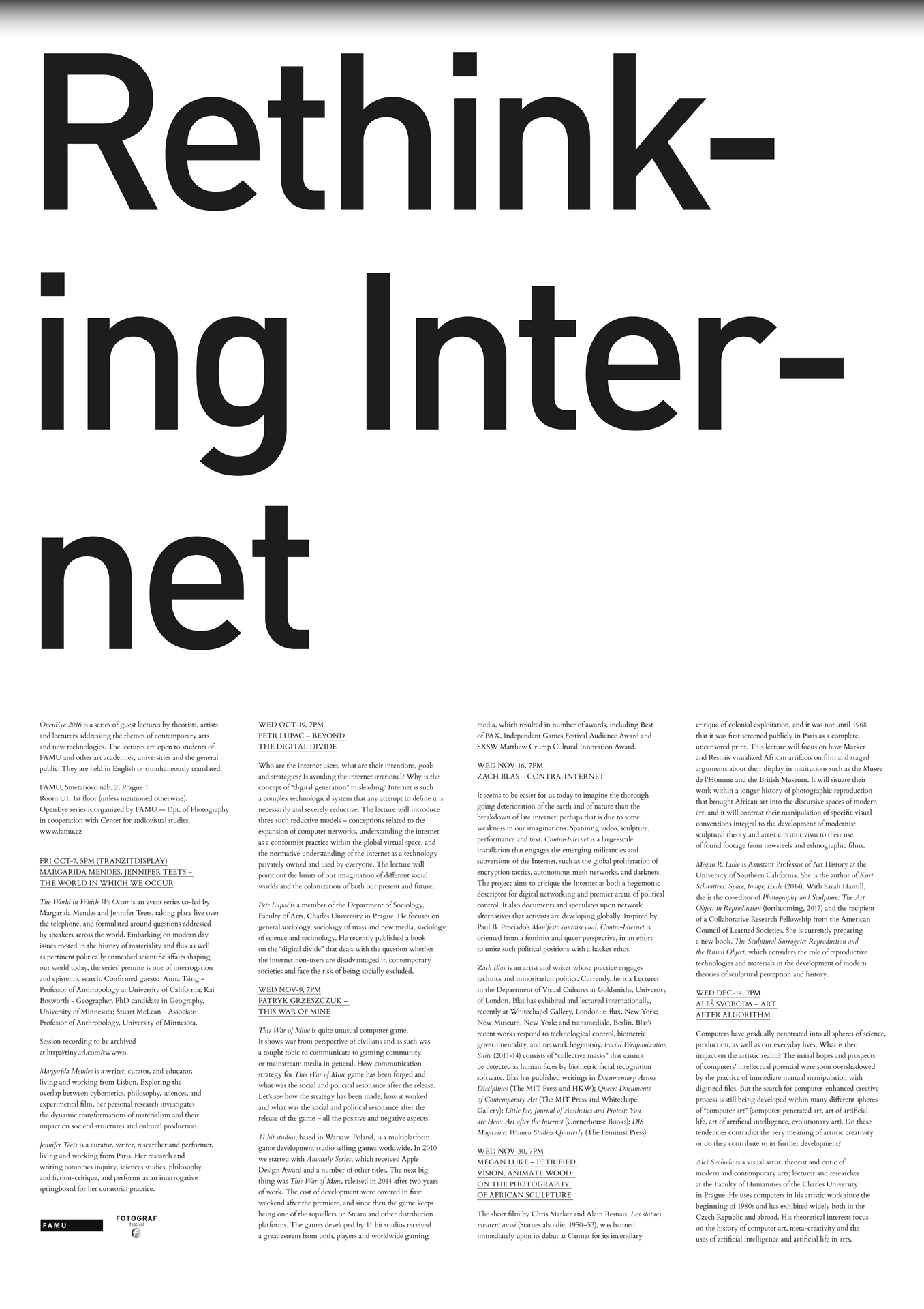

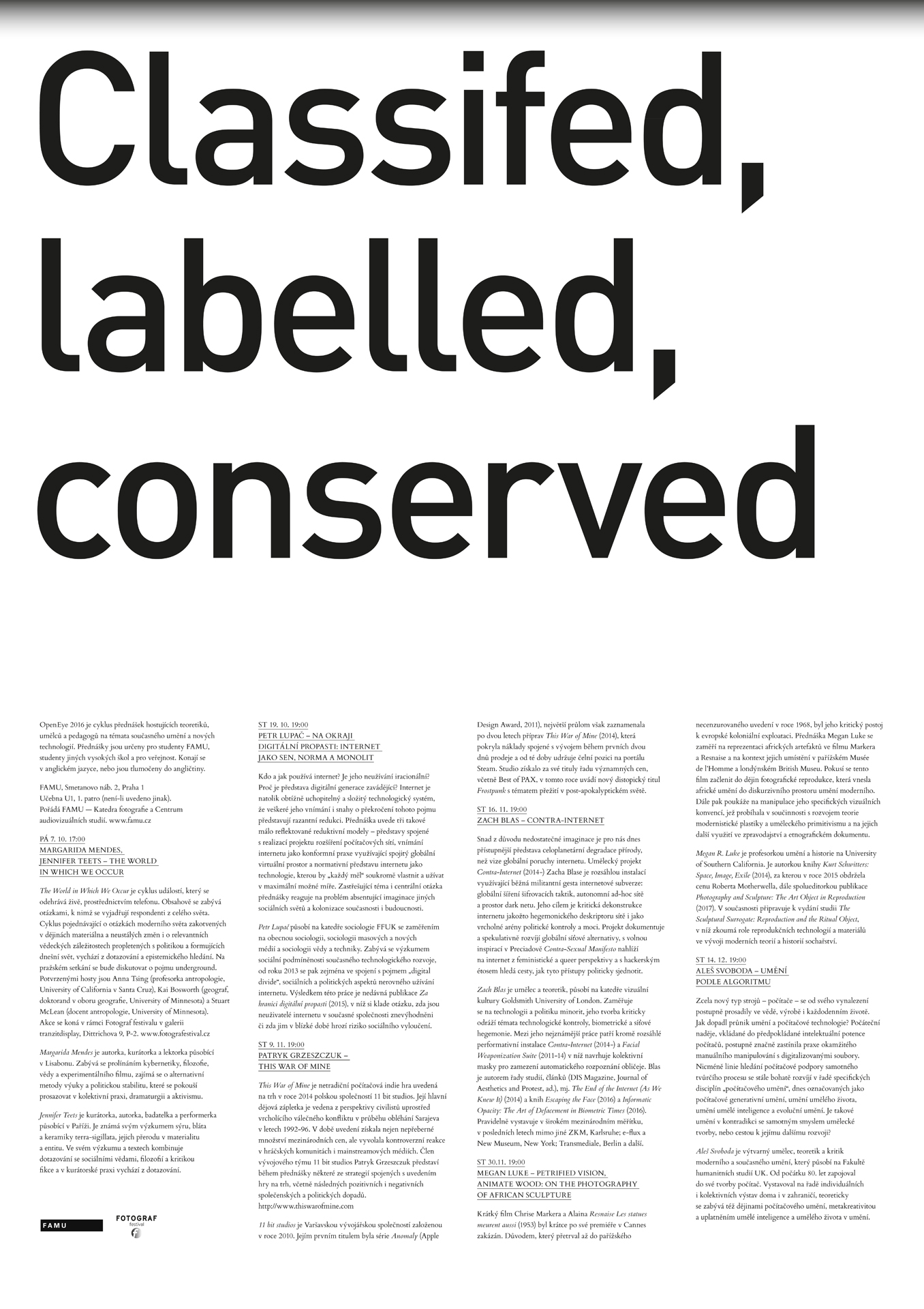
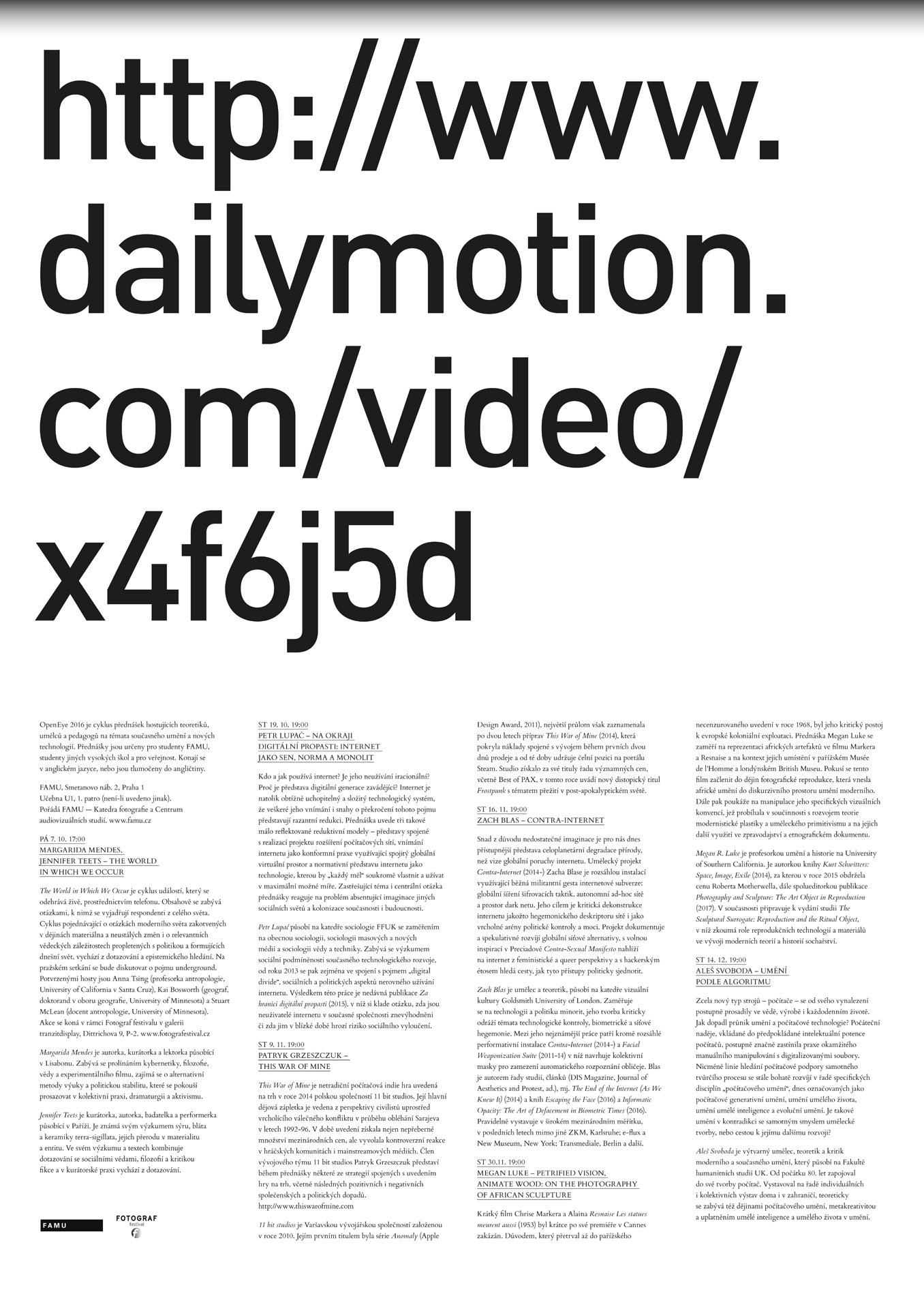
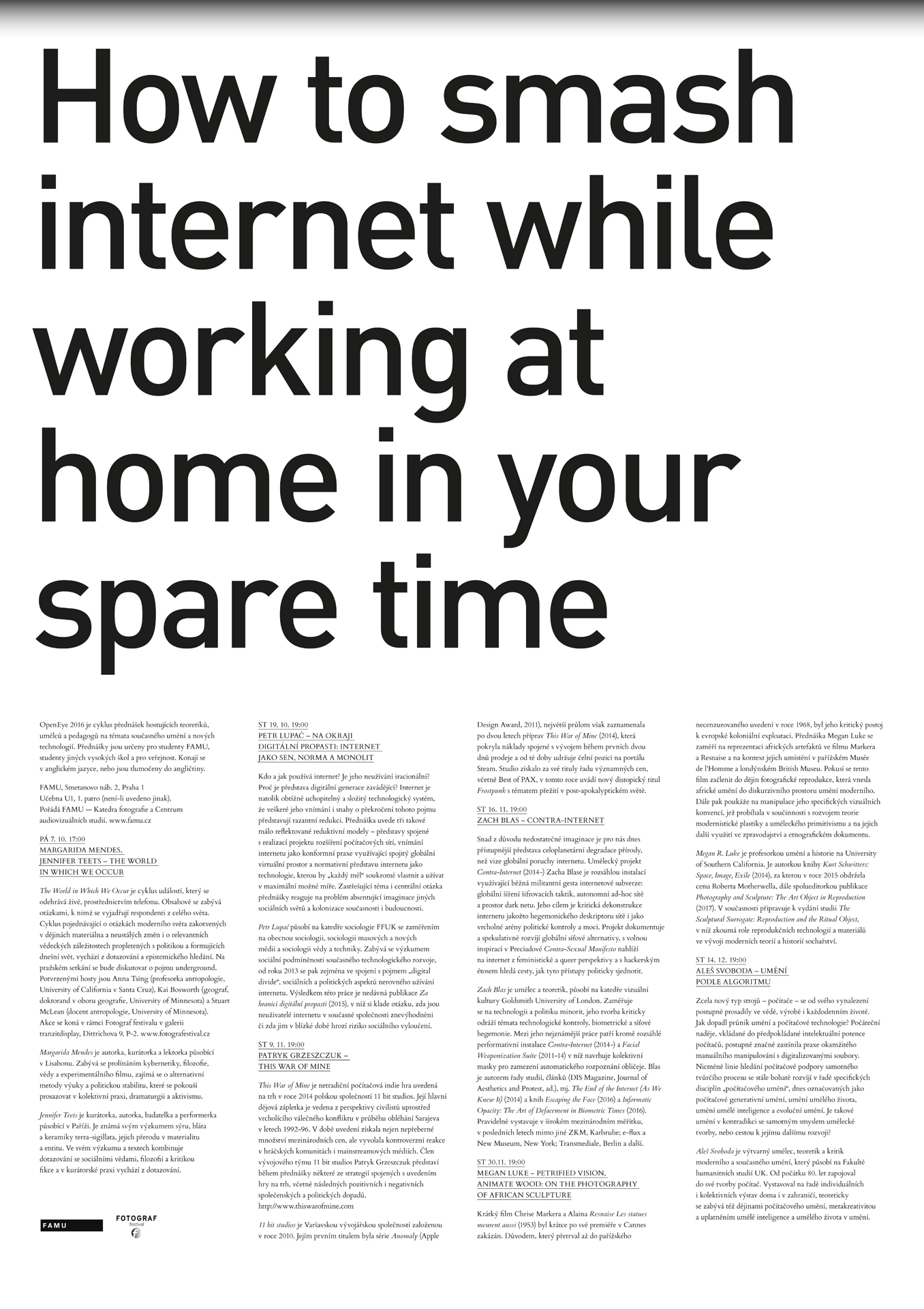
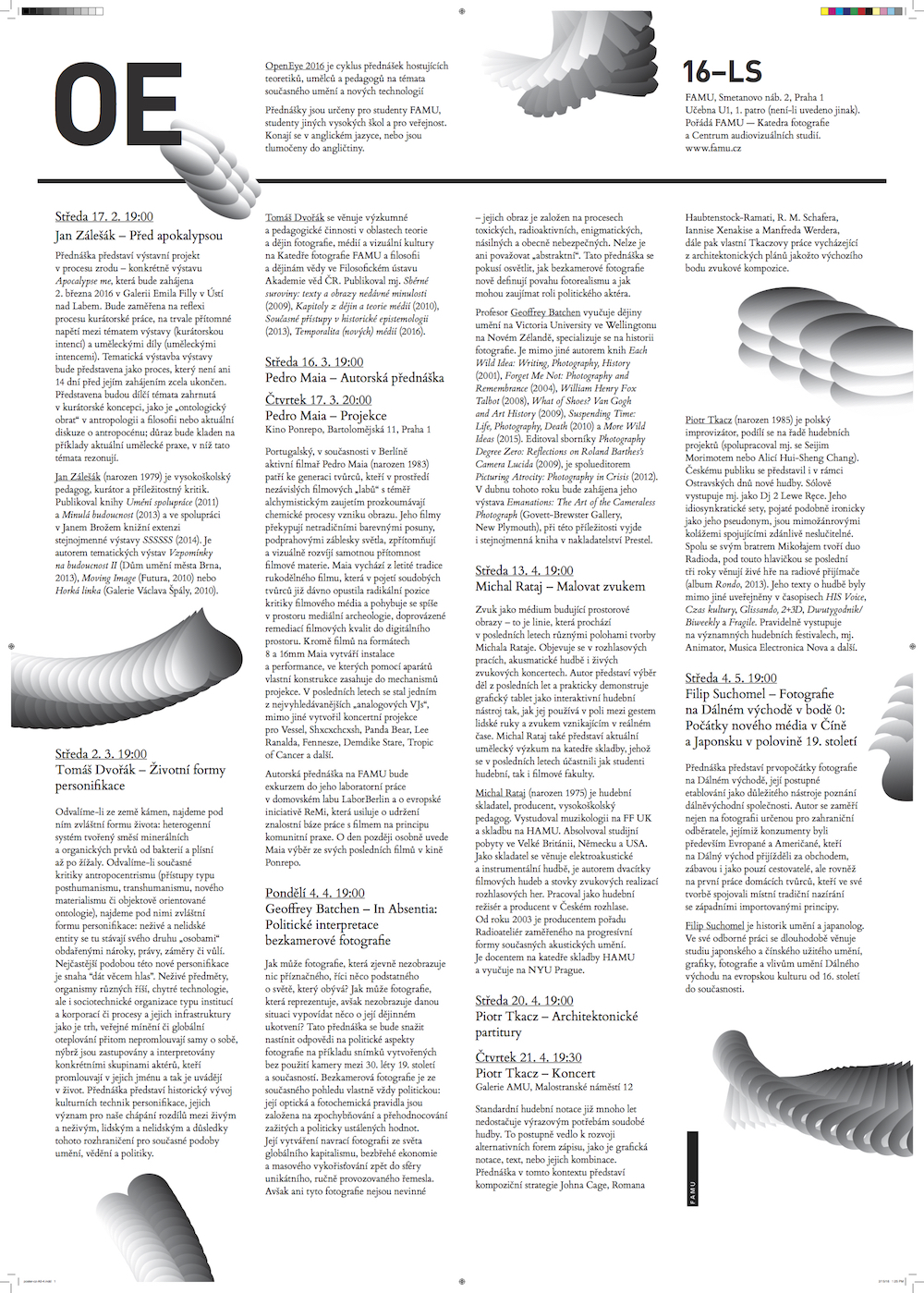
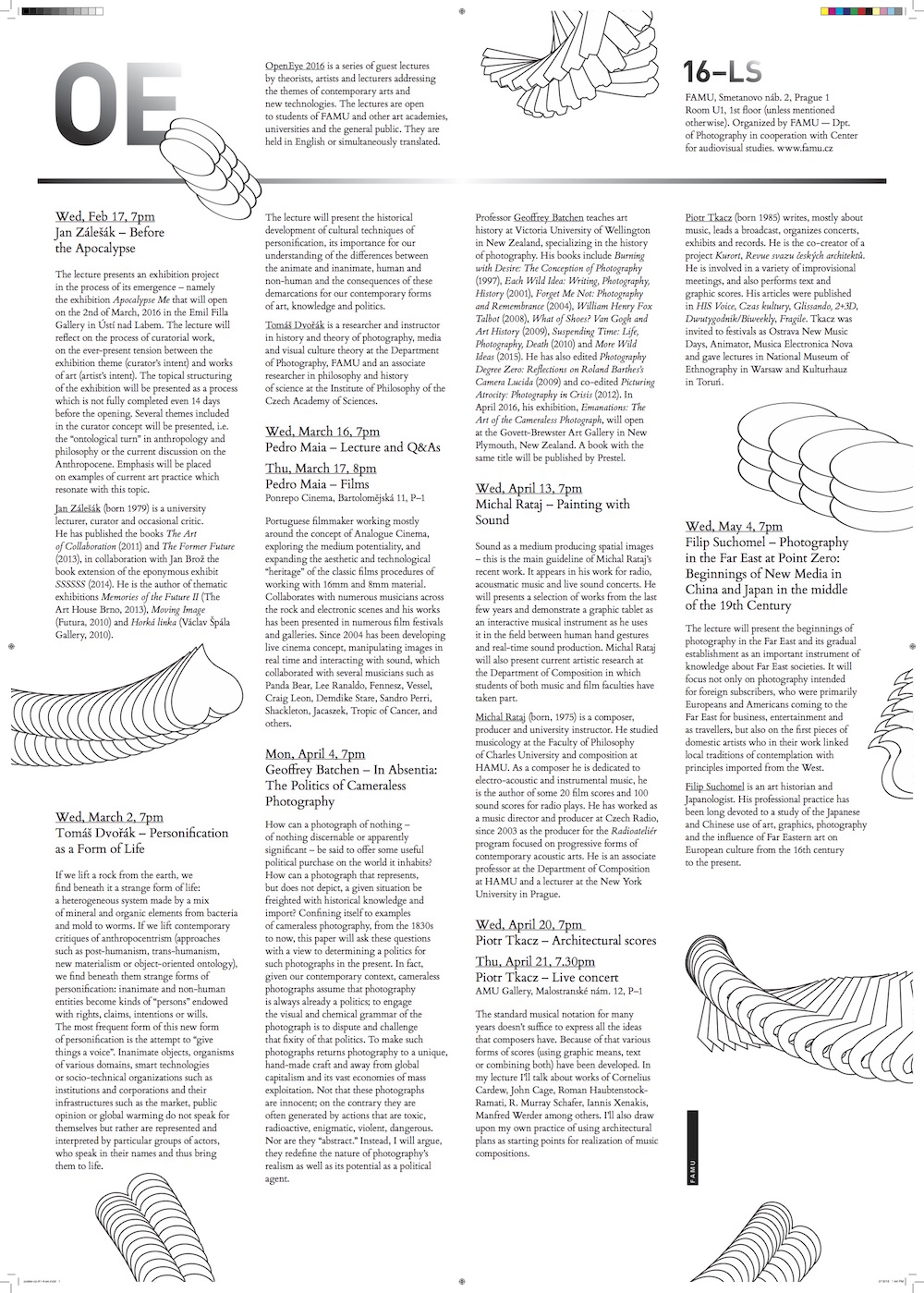
17. 2. 19:00
Jan Zálešák – Before the Apocalypse
The lecture presents an exhibition project in the process of its emergence – namely the exhibition Apocalypse Me that will open on the 2nd of March, 2016 in the Emil Filla Gallery in Ústí nad Labem. The lecture will reflect on the process of curatorial work, on the ever-present tension between the exhibition theme (curator’s intent) and works of art (artist’s intent). The topical structuring of the exhibition will be presented as a process which is not fully completed even 14 days before the opening. Several themes included in the curator concept will be presented, i.e. the “ontological turn” in anthropology and philosophy or the current discussion on the Anthropocene. Emphasis will be placed on examples of current art practice which resonate with this topic.
Jan Zálešák (born 1979) is a university lecturer, curator and occasional critic. He has published the books The Art of Collaboration (2011) and The Former Future (2013), in collaboration with Jan Brož the book extension of the eponymous exhibit SSSSSS (2014). He is the author of thematic exhibitions Memories of the Future II (The Art House Brno, 2013), Moving Image (Futura, 2010) and Horká linka (Václav Špála Gallery, 2010).
2. 3. 19:00
Tomáš Dvořák – Personification as a Form of Life
If we lift a rock from the earth, we find beneath it a strange form of life: a heterogeneous system made by a mix of mineral and organic elements from bacteria and mold to worms. If we lift contemporary critiques of anthropocentrism (approaches such as post-humanism, trans-humanism, new materialism or object-oriented ontology), we find beneath them strange forms of personification: inanimate and non-human entities become kinds of “persons” endowed with rights, claims, intentions or wills. The most frequent form of this new form of personification is the attempt to “give things a voice”. Inanimate objects, organisms of various domains, smart technologies or socio-technical organizations such as institutions and corporations and their infrastructures such as the market, public opinion or global warming do not speak for themselves but rather are represented and interpreted by particular groups of actors, who speak in their names and thus bring them to life. The lecture will present the historical development of cultural techniques of personification, its importance for our understanding of the differences between the animate and inanimate, human and non-human and the consequences of these demarcations for our contemporary forms of art, knowledge and politics.
Tomáš Dvořák, Ph.D. is a researcher and instructor in history and theory of photography, media and visual culture theory at the Department of Photography, FAMU and an associate researcher in philosophy and history of science at the Institute of Philosophy of the Czech Academy of Sciences.
16. 3. 19:00
Pedro Maia – Lecture and Q&As
FAMU, Smetanovo náb. 2, 1. patro, U1
17. 3. 20:00
Pedro Maia – Films
Ponrepo Cinema
Portuguese filmmaker working mostly around the concept of Analogue Cinema, exploring the medium potentiality, and expanding the aesthetic and technological “heritage” of the classic films procedures of working with 16mm and 8mm material. Collaborates with numerous musicians across the rock and electronic scenes and his works has been presented in numerous film festivals and galleries. Since 2004 has been developing live cinema concept, manipulating images in real time and interacting with sound, which collaborated with several musicians such as Panda Bear, Lee Ranaldo, Fennesz, Vessel, Craig Leon, Demdike Stare, Sandro Perri, Shackleton, Jacaszek, Tropic of Cancer, and others.
4. 4. 19:00
Geoffrey Batchen – In Absentia: The Politics of Cameraless Photography
How can a photograph of nothing – of nothing discernable or apparently significant – be said to offer some useful political purchase on the world it inhabits? How can a photograph that represents, but does not depict, a given situation be freighted with historical knowledge and import? Confining itself to examples of cameraless photography, from the 1830s to now, this paper will ask these questions with a view to determining a politics for such photographs in the present. In fact, given our contemporary context, cameraless photographs assume that photography is always already a politics; to engage the visual and chemical grammar of the photograph is to dispute and challenge that fixity of that politics. To make such photographs returns photography to a unique, hand-made craft and away from global capitalism and its vast economies of mass exploitation. Not that these photographs are innocent; on the contrary they are often generated by actions that are toxic, radioactive, enigmatic, violent, dangerous. Nor are they “abstract.” Instead, I will argue, they redefine the nature of photography’s realism as well as its potential as a political agent.
Professor Geoffrey Batchen teaches art history at Victoria University of Wellington in New Zealand, specializing in the history of photography. His books include Burning with Desire: The Conception of Photography (1997), Each Wild Idea: Writing, Photography, History (2001), Forget Me Not: Photography and Remembrance (2004), William Henry Fox Talbot (2008), What of Shoes? Van Gogh and Art History (2009), Suspending Time: Life, Photography, Death (2010) and More Wild Ideas (forthcoming in Chinese, 2015). He has also edited Photography Degree Zero: Reflections on Roland Barthes's Camera Lucida (2009) and co-edited Picturing Atrocity: Photography in Crisis (2012). In April 2016, his exhibition, Emanations: The Art of the Cameraless Photograph, will open at the Govett-Brewster Art Gallery in New Plymouth, New Zealand. A book with the same title will be published by Prestel.
13. 4. 19:00
Michal Rataj – Painting with Sound
Sound as a medium producing spatial images – this is the main guideline of Michal Rataj’s recent work. It appears in his work for radio, acousmatic music and live sound concerts. He will presents a selection of works from the last few years and demonstrate a graphic tablet as an interactive musical instrument as he uses it in the field between human hand gestures and real-time sound production. Michal Rataj will also present current artistic research at the Department of Composition in which students of both music and film faculties have taken part.
Michal Rataj (born, 1975) is a composer, producer and university instructor. He studied musicology at the Faculty of Philosophy of Charles University and composition at HAMU. As a composer he is dedicated to electro-acoustic and instrumental music, he is the author of some 20 film scores and 100 sound scores for radio plays. He has worked as a music director and producer at Czech Radio, since 2003 as the producer for the Radioateliér program focused on progressive forms of contemporary acoustic arts. He is an associate professor at the Department of Composition at HAMU and a lecturer at the New York University in Prague.
20. 4. 19:00
Piotr Tkacz – Architectural scores
FAMU, Smetanovo náb. 2, 1. patro, U1
21. 4. 19:30
Piotr Tkacz – Live concert
Galerie AMU, Malostranské náměstí 12
The standard musical notation for many years doesn't suffice to express all the ideas that composers have. Because of that various forms of scores (using graphic means, text or combining both) have been developed. In my lecture I'll talk about works of Cornelius Cardew, John Cage, Roman Haubtenstock-Ramati, R. Murray Schafer, Iannis Xenakis, Manfred Werder among others. I'll also draw upon my own practice of using architectural plans as starting points for realization of music compositions.
Piotr Tkacz (born 1985) writes, mostly about music, leads a broadcast, organizes concerts, exhibits and records. He is the co-creator of a project Kurort, Revue svazu českých architektů, Stupor, he is opend on variety of improvisional meetings, and also performs text and graphic scores. His articles were published in HIS Voice, Czas kultury, Glissando, 2+3D, Dwutygodnik/Biweekly, Fragile. Tkacz was invited to festivals as Ostrava New Music Days, Animator, Musica Electronica Nova and gave lectures in National Museum of Ethnography in Warsaw and Kulturhauz in Toruń.
4. 5. 19:00
Filip Suchomel – Photography in the Far East at Point Zero: Beginnings of New Media in China and Japan in the middle of the 19th Century
The lecture will present the beginnings of photography in the Far East and its gradual establishment as an important instrument of knowledge about Far East societies. It will focus not only on photography intended for foreign subscribers, who were primarily Europeans and Americans coming to the Far East for business, entertainment and as travellers, but also on the first pieces of domestic artists who in their work linked local traditions of contemplation with principles imported from the West.
PhDr. Filip Suchomel, Ph.D. is an art historian and Japanologist. His professional practice has been long devoted to a study of the Japanese and Chinese use of art, graphics, photography and the influence of Far Eastern art on European culture from the 16th century to the present.
Fri Oct-7 5pm (Tranzitdisplay)
Margarida Mendes, Jennifer Teets – The World in Which We Occur
The World in Which We Occur is an event series co-led by Margarida Mendes and Jennifer Teets, taking place live over the telephone, and formulated around questions addressed by speakers across the world. Embarking on modern day issues rooted in the history of materiality and flux as well as pertinent politically enmeshed scientific affairs shaping our world today, the series’ premise is one of interrogation and epistemic search. Confirmed guests: Anna Tsing - Professor of Anthropology at University of California, Santa Cruz; Kai Bosworth - Geographer, PhD candidate in Geography, University of Minnesota; Stuart McLean - Associate Professor of Anthropology at the University of Minnesota
Margarida Mendes is a writer, curator, and educator, living and working from Lisbon. In 2009, she founded the project space The Barber Shop in Lisbon, where she hosts a programme of seminars and residencies dedicated to artistic and philosophical research. Exploring the overlap between cybernetics, philosophy, sciences, and experimental film, her personal research investigates the dynamic transformations of materialism and their impact on societal structures and cultural production. She is interested in exploring alternative modes of education and political resilience through her collaborative practice, programming, and activism. She recently formed part of the curatorial team of the 11th Gwangju Biennale and curated Matter Fictions at Museu Berardo, Lisbon.
Jennifer Teets is a curator, writer, researcher and performer, living and working from Paris. She is known for her research on cheese, mud, and terra-sigillata – their transitioning towards materiality and entity and their ability to become something else when put in an exhibition or an essay. Her research and writing combines inquiry, sciences studies, philosophy, and fiction-critique, and performs as an interrogative springboard for her curatorial practice. She recently exhibited (with Lorenzo Cirrincione) Elusive Earths III at Parallel, Oaxaca, Mexico.
Wed Oct-19, 7pm
Petr Lupač – Beyond the Digital Divide
Who are the internet users, what are their intentions, goals and strategies? Is avoiding the internet irrational? Why is the concept of “digital generation” misleading? Internet is such a complex technological system that any attempt to define it is necessarily and severely reductive. The lecture will introduce three such reductive models – conceptions related to the expansion of computer networks, understanding the internet as a conformist practice within the global virtual space, and the normative understanding of the internet as a technology privately owned and used by everyone. The lecture will point out the limits of our imagination of different social worlds and the colonization of both our present and future.
Petr Lupač is a member of the Department of Sociology, Faculty of Arts, Charles University in Prague. He focuses on general sociology, sociology of mass and new media, sociology of science and technology. He recently published a book on the “digital divide” that deals with the question whether the internet non-users are disadvantaged in contemporary societies and face the risk of being socially excluded.
Wed Nov-11, 7pm
Patryk Grzeszczuk – This War of Mine
This War of Mine is quite unusual computer game. It shows war from perspective of civilians and as such was a tought topic to communicate to gaming community or mainstream media in general. How communication strategy for This War of Mine game has been forged and what was the social and policital resonance after the release. Let’s see how the strategy has been made, how it worked and what was the social and political resonance after the release of the game – all the positive and negative aspects.
11 bit studios, based in Warsaw, Poland, is a multiplatform game development studio selling games worldwide. In 2010 we started with Anomaly Series, which received Apple Design Award and a number of other titles. The next big thing was This War of Mine, released in 2014 after two years of work. The cost of development were covered in first weekend after the premiere, and since then the game keeps being one of the topsellers on Steam and other distribution platforms. The games developed by 11 bit studios received a great esteem from both, players and worldwide gaming media, which resulted in number of awards, including Best of PAX, Independent Games Festival Audience Award and SXSW Matthew Crump Cultural Innovation Award, Games4Change Best Gameplay & People’s Choice Award at G4C.
Wed Nov-16, 7pm
Zach Blas – Contra-internet
It seems to be easier for us today to imagine the thorough going deterioration of the earth and of nature than the breakdown of late internet; perhaps that is due to some weakness in our imaginations. Spanning video, sculpture, performance and text, Contra-Internet is a large-scale installation that engages the emerging militancies and subversions of the Internet, such as the global proliferation of encryption tactics, autonomous mesh networks, and darknets. The project aims to critique the Internet as both a hegemonic descriptor for digital networking and premier arena of political control. It also documents and speculates upon network alternatives that activists are developing globally. Inspired by Paul B. Preciado’s Manifesto contrasexual, Contra-Internet is oriented from a feminist and queer perspective, in an effort to unite such political positions with a hacker ethos. Contra-Internet functions as an expansive conceptual, practical, and experimental framework for refusing the control logic of the Internet while building alternatives to its infrastructure.
Zach Blas is an artist and writer whose practice engages technics and minoritarian politics. Currently, he is a Lecturer in the Department of Visual Cultures at Goldsmiths, University of London. Blas has exhibited and lectured internationally, recently at Whitechapel Gallery, London; ZKM Center for Art and Media, Karlsruhe; Institute of Contemporary Arts, London; e-flux, New York; Institute of Modern Art, Brisbane; New Museum, New York; Museo Universitario Arte Contemporáneo, Mexico City; and transmediale, Berlin. Residencies include Eyebeam in New York, The Moving Museum Istanbul, The Banff Centre, and the Delfina Foundation in London. Blas’s recent works respond to technological control, biometric governmentality, and network hegemony. Facial Weaponization Suite (2011-14) consists of “collective masks” that cannot be detected as human faces by biometric facial recognition software. Contra-Internet (2014-present) explores subversions of and alternatives to the internet and is supported by a 2016 Creative Capital award in Emerging Fields. Blas is producing two books, Escaping the Face, an artist monograph to be published by Sternberg Press, and Informatic Opacity: The Art of Defacement in Biometric Times, a theoretical study that considers biometric facial recognition as an emerging form of global governance alongside aesthetico-political refusals of recognition, such as masked protest. Blas has published writings in Documentary Across Disciplines (The MIT Press and Haus der Kulturen der Welt); Queer: Documents of Contemporary Art (The MIT Press and Whitechapel Gallery); Little Joe; Journal of Aesthetics and Protest; You are Here: Art after the Internet (Cornerhouse Books); DIS Magazine; Women Studies Quarterly (The Feminist Press); and co-edited micha cárdenas’ The Transreal: Political Aesthetics of Crossing Realities (Atropos Press). His work has been written about and featured in Artforum, Art Review, Frieze, Art Papers, Hyperallergic, Mousse Magazine, The Atlantic, Al Jazeera America, and Wired. Blas holds a PhD from the Program in Literature at Duke University and a MFA from the University of California, Los Angeles.
Wed Nov-30, 7pm
Megan Luke – Petrified Vision, Animate Wood: On the Photography of African Sculpture
The short film by Chris Marker and Alain Resnais, Les statues meurent aussi (Statues also die, 1950–53), was banned immediately upon its debut at Cannes for its incendiary critique of colonial exploitation, and it was not until 1968 that it was first screened publicly in Paris as a complete, uncensored print. This lecture will focus on how Marker and Resnais visualized African artifacts on film and staged arguments about their display in institutions such as the Musée de l’Homme and the British Museum. It will situate their work within a longer history of photographic reproduction that brought African art into the discursive spaces of modern art, and it will contrast their manipulation of specific visual conventions integral to the development of modernist sculptural theory and artistic primitivism to their use of found footage from newsreels and ethnographic films.
Megan R. Luke is Assistant Professor of Art History at the University of Southern California. She is the author of Kurt Schwitters: Space, Image, Exile (University of Chicago Press, 2014), which received the 2015 Robert Motherwell Book Award. With Sarah Hamill (Oberlin College), she is the co-editor of Photography and Sculpture: The Art Object in Reproduction (forthcoming, Getty Publications, 2017) and the recipient of a Collaborative Research Fellowship from the American Council of Learned Societies. She is currently preparing a new book, The Sculptural Surrogate: Reproduction and the Ritual Object, which considers the role of reproductive technologies and materials in the development of modern theories of sculptural perception and history.
Wed Dec-14, 7pm
Aleš Svoboda – Art After Algorithm
Computers have gradually penetrated into all spheres of science, production, as well as our everyday lives. What is their impact on the artistic realm? The initial hopes and prospects of computers’ intellectual potential were soon overshadowed by the practice of immediate manual manipulation with digitized files. But the search for computer-enhanced creative process is still being developed within many different spheres of “computer art” (computer-generated art, art of artificial life, art of artificial intelligence, evolutionary art). Do these tendencies contradict the very meaning of artistic creativity or do they contribute to its further development?
Aleš Svoboda is a visual artist, theorist and critic of modern and contemporary arts; lecturer and researcher at the Faculty of Humanities of the Charles University in Prague. He uses computers in his artistic work since the beginning of 1980s and has exhibited widely both in the Czech Republic and abroad. His theoretical interests focus on the history of computer art, meta-creativity and the uses of artificial intelligence and artificial life in arts.